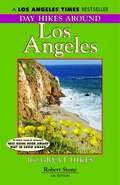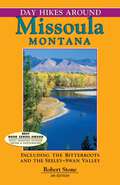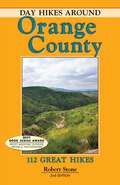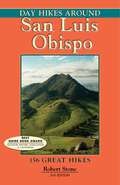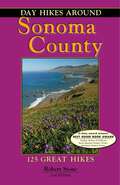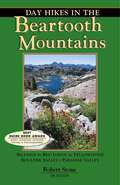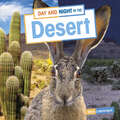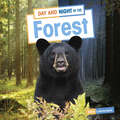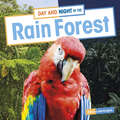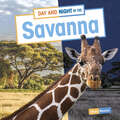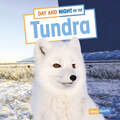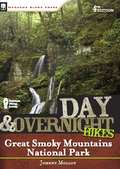- Table View
- List View
Day Hikes Around Big Sur: 99 Great Hikes
by Robert StoneBig Sur is an awesome stretch of spectacular coastline in Central California. The Santa Lucia Mountains quickly rise over 5,000 feet from the ocean. This magnificent landscape begins near Carmel at Point Lobos State Reserve and extends 75 miles south to Ragged Point in San Luis Obispo County, just south of the Monterey County line. The steep coastal mountain range and rugged shoreline isolate the Big Sur country, which maintains an unspoiled, rustic charm and relaxed, leisurely pace.This completely revised and updated edition of Day Hikes Around Big Sur includes 99 great day hikes along the coast and throughout the interior mountains. Hikes, which take from one hour to all day, range from easy beach strolls to strenuous mountain climbs with panoramic coastal vistas. The diverse terrain is a hiker’s paradise with a well-designed trail system of more than 300 miles. The network of trails venture into the beautiful canyons and across the slopes and peaks, offering unparalleled views of the mountains merging with the coastline. Along Highway 1 are endless views of the scalloped coastline and the deep blue Pacific. Awe-inspiring bridges span numerous creeks and deep canyons. Highlights along the miles of trails include isolated beaches, eroded coves with tide pools, rugged marine terraces, redwood and Monterey cypress groves, shady canyons, waterfalls dropping into mossy glens, lighthouses, and vertical cliffs with crested ridges.Statistics, accurate driving and hiking directions, and numerous maps make these hiking adventures stress free. Dog admission information is included. Most trails can be accessed from Carmel Valley Road or Highway 1, including many beach access points.Companion guides include Day Hikes Around Monterey and Carmel and Day Hikes On the California Central Coast.
Day Hikes Around Bozeman, Montana: Including the Gallatin Canyon and Paradise Valley
by Robert StoneBozeman, Montana is a mountain community steeped in history and surrounded by stunning landscape. The city lies between the Gallatin and Yellowstone River valleys amidst several mountain ranges. The fantastic scenery combined with national forests, wilderness areas, and an outdoor-oriented community make the hiking in this area superb.Day Hikes Around Bozeman, Montana has won awards from both the Northwest Outdoor Writers Association and the Rocky Mountain Outdoor Writers and Photographers. Now in its fourth edition, the book includes 110 of the best day hikes in a straight-forward, hassle-free guide aimed to get you on the trails. These hikes explore the mountain ranges and valleys that converge around Bozeman, including the Bridgers, Gallatin Canyon, the Spanish Peaks, the Gallatin Range, and Paradise Valley. Many trails are located with the city itself, which boasts a thriving community trail system and an active liberal-arts college. The Gallatin National Forest, part of the greater Yellowstone ecosystem that stretches to Bozeman, spreads across 1.8-million acres and six mountain ranges around the city. Trail highlights include waterfalls, alpine lakes, sweeping overlooks, valleys surrounded by craggy peaks, petrified forests, historic sites, and the soothing sound of creeks tumbling through forested canyons. Companion guides include Day Hikes In Yellowstone National Park and Day Hikes In the Beartooth Mountains.
Day Hikes Around Los Angeles: 160 Great Hikes (STK-001)
by Robert StoneLA Times Best Seller and four-time award winner from three Outdoor Writers Associations (including Best in Show and Best Guidebook). Now in its 6th edition, Day Hikes Around Los Angeles includes 160 hikes in and around a 50-mile radius of the city. Residents and adventuresome travelers will find the book essential to discovering an amazing number of hiking opportunities.Despite the widespread presence of the Los Angeles metropolis, there exists thousands of acres of natural, undeveloped land and countless out-of-way hiking trails. Hikes range from boardwalk strolls along the ocean to shady canyon trails that lead to far-reaching overlooks. Highlights include year-round waterfalls, wildlife preserves, lighthouses, Griffith Park (the country's largest municipal park), the famous "HOLLYWOOD" sign, quiet canyon trails, panoramic vistas of the city and coastline, the rugged terrain of the San Gabriel Mountains, and hikes along the entire length of the Santa Monica Mountains. Intriguing metropolitan walks are also included. All levels of hiking are accommodated, with an emphasis on a mid-range hikes.Companion guides include Day Hikes Around Orange County (south of LA), Day Hikes Around Ventura County (north of LA), Day Hikes On the Southern California Coast, and Day Hikes In the Santa Monica Mountains.
Day Hikes Around Missoula, Montana: Including The Bitterroots And The Seeley-Swan Valley
by Robert StoneMissoula, Montana is an active university town rich in character set in the midst of stunning scenery. The city lies at the hub of five merging valleys and surrounded on all sides by mountain ranges. The Clark Fork, Rattlesnake, and Bitterroot Rivers converge near the city center, where the streets are lined with historic buildings and residences from the National Register. A short distance in any direction leads to national forests and wilderness areas. Outdoor activities abound in the area! Now in its fourth edition, Day Hikes Around Missoula, Montana includes an excellent collection of 102 day hikes within a 100-mile radius of the city. While many hikes are located within the city itself, most are found in the surrounding valleys, mountains, and national forests. Destinations include both popular and remote trails, from easy nature walks to high-elevation overlooks with expansive vistas across Missoula and its mountain ranges. Highlights include several dramatic waterfalls, stream-fed canyons, fertile valleys flanked by mountains, hot springs, suspension bridges, and historic sites from the Lewis and Clark voyage.The author has written extensively on Montana hiking trails and has personally hiked all of these trails. The author's other Rocky Mountain hiking guides include Day Hikes Around Bozeman, Day Hikes In the Beartooth Mountains, Day Hikes In Yellowstone National Park, and Day Hikes In the Grand Tetons. The majority of Stone's 24 hiking guides are in their 3rd, 4th, or 5th editions.
Day Hikes Around Monterey and Carmel: 127 Great Hikes
by Robert StoneMonterey County lies along an incredibly beautiful and scenic coastal stretch of the Pacific Ocean in Central California. The rugged, weathered shoreline is fronted by the Santa Lucia Mountains, separating the coast from the rich agricultural land. Carmel, Pacific Grove, Monterey, and other picturesque communities dot a landscape abundant with green valleys, woodlands, beaches, parks, natural preserves, and secluded bays along the oceanfront. This completely updated edition of Day Hikes Around Monterey and Carmel includes 128 hikes from the north end of Monterey Bay to the Big Sur coastline. Many hikes are found along the amazing coastline; other hikes explore the interior mountains and hillsides. The routes have been chosen to offer a great selection of shoreline excursions, beaches, residential paths, wilderness hikes, cool canyons, and panoramic overlooks while including a range of hiking levels. Coastal walks include blufftop terraces, tidepools, coves, massive sand dunes, whale-watching locations, tidal marshes along the Pacific Flyway, and breath-taking hillside routes along dramatic headlands carved by the pounding surf. Scenic neighborhood walks link piers, boardwalks, and natural areas. Some trails include atmospheric forests of old-growth redwoods, rare stands of Monterey cypress, or California condor nesting sites amongst craggy rock pinnacles. Other highlights include lighthouses, historic sites, long-spanning bridges, ridgetop overlooks, sweeping coastal views, and paths alongside the Monterey Bay Aquarium and marine refuge. Hikes take from one hour to all day. A range of hikes is included to accommodate every level of experience. All trails can be accessed from Highway 1, including many beach access points.Companion guides include Day Hikes Around Big Sur and Day Hikes On the California Central Coast.
Day Hikes Around Orange County: 112 Great Hikes
by Robert StoneOrange County lies along the coast in southern California between Los Angeles and San Diego. The county is framed by the Pacific Ocean on one side while the Santa Ana Mountains stretch along the entire back side of the county. The coast-to-mountain landscape creates an interesting, diverse terrain that offers many opportunities for exploration. Despite the urban encroachment, nearly 30% of Orange County is preserved as city parklands, wilderness preserves, national forests, and state parks. Along the county&’s 44 miles of shoreline reside long stretches of sandy beaches, marine terraces, and promontories. The Cleveland National Forest and the San Mateo Canyon Wilderness cover thousands of acres of forested canyons and plateaus in the Santa Ana Range. This essential guide describes how to get to backcountry trailheads in the Santa Anas, the best trails to hike in the county's expansive parklands, and where to find access points to the coastline. Several inviting urban routes are included as well. Highlights of the hikes include sheltered coves, tidal estuaries, forested canyons, cascades, weathered sandstone peaks, and vista points that offer views from the ocean to the cities. A range of hikes is included, from easy coastal walks to strenuous hillside climbs. Statistics, accurate directions, and a map for every hike makes these adventures stress free. Dog access information is included, as well as a thorough index.Companion guides include Day Hikes On the California Southern Coast and Day Hikes Around Los Angeles.
Day Hikes Around San Luis Obispo: 156 Great Hikes
by Robert StoneWinner of the Best Guidebook Award from Outdoor Writers Association of California! San Luis Obispo County is located where the white sand beaches of Central California merge with the dramatic Big Sur coastline. Ranging inland from the Pacific Ocean are oak-studded hills, verdant farmland, pristine mountain lakes, and the 5,000-foot Santa Lucia Range of the Los Padres National Forest. The unique geography and a temperate, year-round climate creates an outstanding hiking environment.Day Hikes Around San Luis Obispo now includes over 150 day hikes throughout the coastal county. This greatly expanded third edition is easily the most comprehensive hiking guide in the area. The trails take the hiker along the scalloped Pacific coastline to secluded coves and tide pools, to rocky promontories along the chain of volcanic morros, through wetland sanctuaries, across massive sand dunes, and up cool interior canyons. Highlights include waterfalls, bluffs, long stretches of beach, lighthouses, lakes, rivers, swimming holes, extraordinary rock formations, and panoramic views that span from the inland mountains to the ocean. Many hikes are found in or near San Luis Obispo, although most hikes are located in undeveloped tracts of land and along 100 miles of coastline. A range of hikes is included, from easy coastal walks to high elevation climbs.Statistics, accurate driving and hiking directions, and numerous maps make these hiking adventures stress free. Dog admission information is included as well as an index.Companion guides include Day Hikes On the Central California Coast, Day Hikes Around Big Sur, and Day Hikes Around Santa Barbara.
Day Hikes Around Santa Barbara: 113 Great Hikes
by Robert StoneSanta Barbara is a captivating, inviting community that is located in a natural, beautiful setting along California's Pacific coast. The temperate climate and refreshing ocean breezes, very similar to the Mediterranean, have distinguished this area as "the jewel of the American Riviera." The landscape around the city includes mountainous terrain, preserved forests and wilderness areas, and stretches of undeveloped coast, allowing this scenic area to have miles of quiet, secluded hiking trails.Day Hikes Around Santa Barbara includes 113 day hikes within a 65-mile radius of the city. A wide range of hikes accommodates amateur to avid hikers, ranging from coastal beach walks to steep canyon climbs. Highlights include oceanside bluffs, beaches, tidepools, wetland preserves, sculpted gorges, rock outcroppings with caves, numerous waterfalls, secluded pools in mossy canyons, mountain ridge trails, historical sites, and stunning overlooks of the Pacific. Straight-forward directions and clear maps accompany every hike.Companion guides include Day Hikes Around Ventura County, Day Hikes Around San Luis Obispo, and Day Hikes On the California Central Coast.
Day Hikes Around Santa Barbara: 116 Great Hikes
by Robert StoneSanta Barbara is a captivating, inviting community that is located in a natural, beautiful setting along California's Pacific coast. The city is located 90 miles north of Los Angeles and 100 miles south of San Luis Obispo The temperate climate and refreshing ocean breezes, very similar to the Mediterranean, have distinguished this area as "the jewel of the American Riviera." The landscape includes mountainous terrain, preserved forests and wilderness areas, and stretches of undeveloped coast, allowing this scenic area to have miles of quiet, secluded hiking trails.Day Hikes Around Santa Barbara includes 116 day hikes within a 65-mile radius of the city. Most trails are located in natural, undeveloped areas, including 80 miles of coastline, the Santa Ynez Mountains, and the Santa Ynez River Valley. A few trails through urban areas are included as well. A wide range of hikes accommodates amateur to avid hikers, ranging from coastal beach walks to steep canyon climbs. Highlights include oceanside bluffs, beaches, tidepools, wetland preserves, sculpted gorges, rock outcroppings with caves, numerous waterfalls, secluded pools in mossy canyons, mountain ridge trails, historical sites, and stunning overlooks of the Pacific. Straight-forward directions and clear maps accompany every hike. Companion guides include Day Hikes Around Ventura County, Day Hikes Around San Luis Obispo, and Day Hikes On the California Central Coast.
Day Hikes Around Sedona, Arizona: 100 Great Hikes
by Robert StoneThere is an old saying, "God created the Grand Canyon, but he lives in Sedona." The Sedona region is home to extraordinary red rock formations, natural arches, majestic pinnacles, cliffs, gorges, sculpted canyons, mesas with panoramic views, ancient Indian ruins, plus year-round creeks and swimming holes. Sedona offers an abundance of outdoor activities, and hiking is one of the most popular. Day Hikes Around Sedona is a comprehensive guide to the extensive network of trails throughout this beautiful area. These one hundred hikes include trails to all the best-known rock formations, as well as secluded trails that travel down remote canyons, across vast plateaus, or lead to archeological sites. Oak Creek gently cascades through town, leaving a corridor of lush vegetation that contrasts with the eroded red rock landscape. Interconnected valleys, canyons, and mesas offer abundant opportunities for hiking and exploration. A range of difficulty levels and scenery is included. All hikes can be completed during the day. Map sources and references are listed for extending the hikes. Each hike includes: >Detailed maps >Accurate driving and hiking directions >Distance, time, and elevation statistics >Summaries to help hikers find a trail appropriate to their ability and desire >Several overall maps to show the hikes in the greater area
Day Hikes Around Sonoma County: 125 Great Hikes
by Robert StoneSonoma County is 35 miles north of San Francisco on the Pacific coast. This California county is known for its wineries and a magnificent natural landscape--a picturesque mix of rugged coastline, steep cliffs, forested hillsides, and verdant agricultural valleys. The cities, towns, and villages are as diverse as the geography. Interspersed throughout the landscape are thousands of acres of undeveloped parklands, forests, and open space.Day Hikes Around Sonoma County is a collection of 125 of the county's best day hikes, providing access to both well-known and out-of-the-way greenspace. Hikes are found along the Pacific Ocean, across the coastal ridges, into wide valleys, and through thick forests. A third of the hikes are located along the coastline, accessed by Highway 1, which connects the coastal towns as it snakes along the oceanfront cliffs and bluffs. Many coastal access points that are not easily recognized from Highway 1 are clearly described. The remaining hikes explore the inland mountains, hillsides, and valleys through numerous state parks, regional parks, and undeveloped land. Highlights include fog-shrouded redwood forests, creekside canyons, wildlife sanctuaries, lakes, tidal bays, wave-pounded coastline, and sweeping panoramic views. A wide range of hikes accommodates amateur to avid hikers, from beachfront strolls to canyon treks. Straight-forward directions and clear maps accompany all hikes. A thorough index includes cities, trails, and points of interest.
Day Hikes Around Ventura County: 116 Great Hikes
by Robert StoneGreatly expanded 3rd edition! Day Hikes Around Ventura County now includes 116 day hikes in this scenic coastal county just north of Los Angeles. The county's diverse topography includes national forest land, wilderness areas, mountain ranges, and over 50 miles of coastline. Miles of hiking trails weave through the open space, parks, forests, and mountain ranges that together form an ecological corridor. In addition, a network of trails are accessible from the metropolitan areas, where the open spaces have been thoughtfully integrated with the development.These hikes range from the Pacific Coast to the mountainous interior and national forests. Highlights include coastal estuaries and tidepools, long beaches backed by bluffs, waterfalls, swimming holes, forested canyons, secluded creek paths, caves, ridge walks, historic sights, filming locations, and rugged outcroppings...from relaxing, scenic strolls to mountain-to-coast hikes with panoramic views.Companion guides include Day Hikes Around Los Angeles, Day Hikes Around Santa Barbara, and Day Hikes On the California Southern Coast.
Day Hikes Around Ventura County: 123 Great Hikes
by Robert StoneVentura County is a scenic coastal county that lies just north of Los Angeles. The diverse topography includes national forest land, wilderness areas, mountain ranges, and over 50 miles of coastline. Miles of hiking trails weave through the open space, parks, forests, and coastal mountains that together form an ecological corridor. In addition, a network of trails are accessible within the metropolitan areas, where the open spaces have been thoughtfully integrated with the development. Day Hikes Around Ventura County is a collection of 123 of the county's best day hikes, providing access to both well-known and out-of-the-way greenspace. These hikes range from the Pacific Coast to the mountainous interior and forests. Highlights include coastal estuaries and tidepools, long beaches backed by bluffs, waterfalls, swimming holes, forested canyons, secluded creek paths, caves, ridge walks, historic sights, filming locations, and rugged outcroppings...from relaxing, scenic strolls to mountain-to-coast hikes with panoramic views. The large number of hikes provides an excellent cross-section of scenery and difficulty levels. Hiking times range from 30 minutes to seven hours. The majority of hikes are 1–3 miles in length. Relevant maps are listed under the the statistics to lengthen the hike if inclined. At least one map is included for every hike. The book is well organized by location and includes a thorough index with entries for points of interest. Companion guides include Day Hikes Around Los Angeles, Day Hikes Around Santa Barbara, and Day Hikes On the California Southern Coast.
Day Hikes In Grand Teton National Park: 89 Great Hikes
by Robert StoneGrand Teton National Park may be one of the most beautiful and awe-inspiring parks of the Rocky Mountains. The craggy Teton peaks reach as high as 13,770 feet, forming a bony ridge through Wyoming along the Continental Divide. Fronting the Teton Range lies the twisting and curving Snake River, winding its way down the Jackson Hole Valley. The reflections of the Tetons gently ripple across the river's serene water.Now in its 5th edition, Day Hikes In Grand Teton National Park includes a thorough selection of 89 day hikes throughout this national park and around the town of Jackson. The hikes include easy-to-follow directions and are well organized by region, making the valley and mountain range easily accessible for everyone. The book offers many options for hiking--from exploring a short distance from the trailhead to climbing thousands of feet in elevation through canyons that lead up to fantastic vantage points. Highlights include lakeshore paths, cascading creeks, rock-walled canyons, panoramic overlooks, waterfalls, hot springs, fishermen trails, prime wildlife habitats, North America's largest landslide, and two hikes atop the Jackson Hole Ski Resort. The hikes range from well-known destinations (like Jenny Lake and Jackson Lake) to quiet, backcountry trails.The author has written extensively on Montana and Wyoming hiking trails and has personally hiked all of these trails. Companion guides include Day Hikes In Yellowstone National Park and Day Hikes In the Beartooth Mountains.
Day Hikes In Yosemite National Park: 80 Great Hikes
by Robert StoneYosemite is one of the world&’s most loved national parks. The park lies in central California on the western slope of the Sierra Nevada Range. It is best known for Yosemite Valley, with its huge granite monoliths and long waterfalls; the rolling, boulder-strewn meadows along the Tuolumne River; and the rugged, snow-capped peaks of the Sierras. More than 90% of Yosemite is roadless wilderness and home to more than 750 miles of trails.This collection of 80 day hikes in and around Yosemite provides access to all of the well-known park features as well as many lesser-known trails and destinations. Highlights include incredible waterfalls, granite monoliths, expansive alpine meadows, giant sequoia groves, and unforgettable views from unique perspectives that are only accessible from the hiking trails. Outstanding scenery surrounds every trail regardless of its difficulty.Companion guides include Day Hikes In Sequoia and Kings Canyon National Parks, Day Hikes Around Sonoma County, and Day Hikes Around Napa Valley.
Day Hikes In the Santa Monica Mountains: From Los Angeles to Point Mugu, including the Entire Backbone Trail
by Robert StoneThe 50-mile-long Santa Monica Mountains parallel the coastline in Southern California, dividing the Pacific coast from the interior valleys. The majority of the range is located within the Santa Monica Mountains National Recreation Area, the world's largest national park at 150,000 acres, including three major state parks. Included in this new guide are 138 day hikes, with an additional section of 13 hikes that traverses the full length of the 68-mile Backbone Trail in day hike segments. There are a variety of hikes to accommodates every level of hiking, from short strolls along boardwalks to all-day coast-to-peak hikes. Also included are clear trail descriptions, ample maps, and an index.
Day Hikes in the Beartooth Mountains: Billings to Red Lodge to Yellowstone
by Robert StoneFantastic hiking for every level of experience! The beautiful Beartooth Mountains rise dramatically from the tawny plains of south-central Montana and stretch to the northern reaches of Yellowstone National Park. These day hikes travel through wooded canyons, valleys enclosed by snow-capped peaks, waterfalls, creeks, alpine plateaus, and stunning mountain panoramas. Hikes range from treks across 10,000-foot alpine tundra in remote wilderness to gentle trails along the Yellowstone River as it stretches through broad valleys. Trails are located within a 120-mile radius of Red Lodge, including Billings, the Beartooth Highway, Boulder Valley, Paradise Valley, and the north end of Yellowstone.
Day and Night in the Desert (Habitat Days and Nights)
by Ellen LabrecqueSpend a day and night in the desert! Learn about this dry habitat through the unique animals that call it home. Stand with meerkats during a watchful hunt for insects. Spot a jackrabbit taking a shaded midday nap. Join a desert tortoise as it dines on colorful cactus fruit. After dark, follow a snake as it slithers in cool, moonlit sand. What will tomorrow bring in the desert?
Day and Night in the Forest (Habitat Days and Nights)
by Ellen LabrecqueSpend a day and night in the forest! Learn about this wooded habitat through the fascinating animals that call it home. Leap from tree to tree with a squirrel searching for breakfast. Pounce with a fox on the forest floor. Soar with a red-tailed hawk as the sun sets. After dark, build a dam with a beaver. What will tomorrow bring in the forest?
Day and Night in the Rain Forest (Habitat Days and Nights)
by Ellen LabrecqueSpend a day and night in the rain forest! Learn about this lush habitat through the diverse animals that call it home. Start the morning suspended high in the canopy with a colorful toucan. Curl around a branch and bask in afternoon sun with an emerald boa. At sunset, pace the forest floor for prey alongside a sleek jaguar. After dark, spy a nocturnal sloth slowly wake after a full day of slumber. What will tomorrow bring in the rain forest?
Day and Night in the Savanna (Habitat Days and Nights)
by Mary BooneSpend a day and night in the savanna! Learn about this grassy habitat through the interesting animals that call it home. Nibble a breakfast of sky-high leaves with a giraffe. Then construct towering mounds with termites. At sunset, shriek and prowl for prey with a pack of hyenas. After dark, go on a high-speed hunt with a cheetah. What will tomorrow bring in the savanna?
Day and Night on the Prairie (Habitat Days and Nights)
by Ellen LabrecqueSpend a day and night in the prairie! Learn about this grassy habitat through the exciting animals that call it home. Spot prairie dogs popping aboveground as morning sun floods a field. Join giant bison as they graze on grass. Stir up dust on a sunset sprint with antelope. After dark, stake out prey with a coyote in dense grass. What will tomorrow bring in the prairie?
Day and Night on the Tundra (Habitat Days and Nights)
by Mary BooneSpend a day and night in the tundra! Learn about this cold habitat through the intriguing animals that call it home. Catch breakfast mid-flight with a peregrine falcon. Spend the afternoon snoozing with an Arctic fox. Take an evening trek with a herd of caribou. After dark, sit still with an Arctic hare as it hides from hungry wolves. What will tomorrow bring in the tundra?
Day and Overnight Hikes: Anza-Borrego Desert State Park
by Sheri McgregorAnza Borrego Desert State Park is the largest desert park in the United States, drawing approximately 650,000 visitors per year. Combining detailed narrative with GPS-based trail maps, Day and Overnight Hikes: Anza-Borrego Desert State Park breaks down the best of the best hikes, both day and overnight. Whether it's the best view over Culp Valley, a walk through Hellhole Canyon, or a flat walk through hills and dales near the Salton Sea, Day and Overnight Hikes is the definitive go-to guide to enjoy the largest desert park in the United States, just an hour's drive from San Diego.
Day and Overnight Hikes: Great Smoky Mountains National Park
by Johnny MolloyWith 500,000 acres of land, it's hard to know where to start in this majestic national park. This fully updated edition of the popular guide eases the process for novice and veteran hikers alike. Comprehensive and compact, the book profiles 31 day-hikes, both one-way and loop, and 10 overnight hikes. Each profile includes a detailed description, maps and trailhead directions, and a trail summary that rates the difficulty, solitude, and scenery of each hike while outlining significant sites along the way. Destinations include the Little Greenbrier Trail to Walker Sisters Place, one of the last working pioneer homesteads in the Smokies, and the remote and stunning Hyatt Ridge Loop. Easily carried in a backpack, this book has hikes suitable for anyone who prefers vacationing on the trail rather than behind another car.


